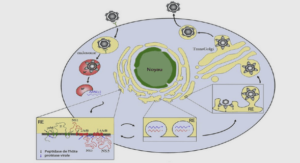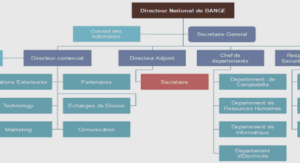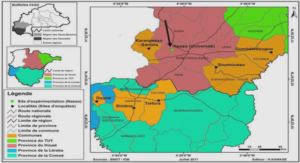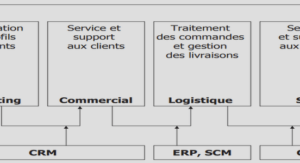Propriétés sismiques du manteau lithosphérique sous le craton du Kaapvaal
La structure du craton du Kaapvaal a été étudiée par de multiples études sismiques au cours des dernières décennies afin de tenter de comprendre l’origine de sa longévité. Toutefois, interpréter ces données en terme de composition ou de température reste ambiguë. La plupart d’entre elles révèlent la présence d’une racine aux vitesses sismiques élevées atteignant au moins 200 km (Chevrot and Zhao, 2007; Fishwick, 2010; James et al., 2001; Li and Burke, 2006; Priestley, 1999; Priestley et al., 2006). Ces vitesses rapides ont tour à tour été attribuées à des changements de température (Priestley and Tilmann, 2009) ou de composition (Begg et al., 2009). Certains modèles tomographiques des ondes de volume montrent de plus faibles vitesses sismiques sous le complexe du Bushveld, ayant été attribuées à des compositions plus fertiles (Fouch et al., 2004; James et al., 2001) ou à un géotherme plus chaud (Fouch et al., 2004). Enfin, la conversion à 150 km mesurée par les fonctions récepteurs pourrait être liée à un changement de composition ou par un contraste d’anisotropie au sein du manteau cratonique (Savage and Silver, 2008; Wittlinger and Farra, 2007). Les études d’anisotropie sismiques révèlent des directions de polarisation des ondes SKS NNE-SSO sur l’ensemble du craton (Silver et al., 2001; Vinnik et al., 1995), interprétées tour à tour comme le produit d’OPRs fossilisées dans la lithosphère (Silver et al., 2001) ou de la réponse de l’asthénosphère au mouvement de la plaque africaine (Vinnik et al., 1995). L’interprétation de ces données n’étant pas unique, elles pourraient donc bénéficier de l’apport d’observations directes de la déformation du manteau lithosphérique et de l’anisotropie qui en résulte. Le travail présenté dans ce chapitre repose sur le calcul des propriétés sismiques de 47 xénolites mantelliques du craton Kaapvaal à partir de leur OPRs et de leurs données de compositions (Baptiste et al., 2012). Il a pour but d’apporter des contraintes sur les vitesses sismiques et les anisotropies possibles au niveau du Kaapvaal, ainsi que de connaître leur Contraintes pétrophysiques sur les propriétés sismiques du manteau lithosphérique sous le craton du Kaapvaal dépendance à la composition et aux OPRs. Cette étude révèle que des changements de l’OPR de l’olivine n’entraînent que des variations mineures des motifs d’anisotropie sismique. L’anisotropie azimutale maximale des ondes P varie entre 2.5 et 10.2%, tandis que l’anisotropie de polarisation maximale des ondes S est comprise entre 2.7 et 8%. Par le calcul des propriétés sismiques moyennes pour des sections de 20 km, nous avons prédis l’anisotropie que devrait mesurer les ondes SKS, Rayleigh et Love pour 5 orientations de foliation et linéation différentes. Les faibles déphasages et les directions de polarisation cohérente sur l’ensemble du craton mesurés par les ondes SKS et la faible anisotropie azimutale avec SH>SV mesurée par les ondes de surface sont le mieux expliquées par une foliation et linéation inclinées de 45°. Les compositions très hétérogènes des péridotites du Kaapvaal entraînent une variation de densité allant jusqu’à 3%, et une variation allant jusqu’à 2.3% de Vp, Vs et du rapport Vp/Vs. Un appauvrissement en Fe lié à la fusion partielle génère une augmentation de Vp et Vs, mais une diminution du rapport Vp/Vs et de la densité. L’enrichissement en orthopyroxène lié au métasomatisme entraîne une diminution de la densité et de Vp, et réduit fortement le rapport Vp/Vs. Un enrichissement en grenat, aussi attribué au métasomatisme, accroît la densité, et plus faiblement Vp et le rapport Vp/Vs. Enfin, la comparaison entre les profiles de vitesse obtenus pour nos échantillons et les modèles de vitesse 1D fournis par les études sismiques du Kaapvaal montre que : (1) les mylonites cratoniques ne représentent que des modifications locales de la racine causées et sur-échantillonnées par les kimberlites (2) les modèles sismiques sous-estiment très certainement l’hétérogénéité compositionnelle de la racine cratonique du Kaapvaal, qui se produit à une échelle bien inférieure à celle qui peut être décrite par les études sismiques.
Petrophysical constraints on the seismic properties of the Kaapvaal craton mantle root
Abstract. We calculated the seismic properties of 47 mantle xenoliths from 9 kimberlitic pipes in the Kaapvaal craton based on their modal composition, the crystal-preferred orientations (CPO) of olivine, ortho- and clinopyroxene, and garnet, the Fe content of olivine, and the pressures and temperatures at which the rocks were equilibrated. These data allow constraining the variation of seismic anisotropy and velocities within the cratonic mantle. The fastest P and S2 wave propagation directions and the polarization of fast split shear waves (S1) are always subparallel to olivine [100] axes of maximum concentration, which marks the lineation (fossil flow direction). Seismic anisotropy is higher for high olivine contents and stronger CPO. Maximum P wave azimuthal anisotropy (AVp) ranges between 2.5 and 10.2 % and the maximum S wave polarization anisotropy (AVs), between 2.7 and 8 %. Changes in olivine CPO symmetry result in minor variations in the seismic anisotropy patterns, mainly in the apparent isotropy directions for shear wave splitting. Seismic properties averaged over 20 km-thick depth sections are, therefore, very homogeneous. Based on these data, we predict the anisotropy that would be measured by SKS, Rayleigh (SV) and Love (SH) waves for five endmember orientations of the foliation and lineation. Comparison to seismic anisotropy data from the Kaapvaal shows that the coherent fast directions, but low delay times imaged by SKS studies, and the low azimuthal anisotropy with with the horizontally polarized S waves (SH) faster than the vertically polarized S wave (SV) measured using surface waves are best explained by homogeneously dipping (45◦ ) foliations and lineations in the cratonic mantle lithosphere. Laterally or vertically varying foliation and lineation orientations with a dominantly NW–SE trend might also explain the low measured anisotropies, but this model should also result in backazimuthal variability of the SKS splitting data, not reported in the seismological data. The strong compositional heterogeneity of the Kaapvaal peridotite xenoliths results in up to 3 % variation in density and in up to 2.3 % variation of Vp, Vs , and Vp/Vs ratio. Fe depletion by melt extraction increases Vp and Vs , but decreases the Vp/Vs ratio and density. Orthopyroxene enrichment due to metasomatism decreases the density and Vp, strongly reducing the Vp/Vs ratio. Garnet enrichment, which was also attributed to metasomatism, increases the density, and in a lesser extent Vp and the Vp/Vs ratio. Comparison of density and seismic velocity profiles calculated using the xenoliths’ compositions and equilibration conditions to seismological data in the Kaapvaal highlights that (i) the thickness of the craton is underestimated in some seismic studies and reaches at least 180 km, (ii) the deep sheared peridotites represent very local modifications caused and oversampled by kimberlites, and (iii) seismological models probably underestimate the compositional heterogeneity in the Kaapvaal mantle root, which occurs at a scale much smaller than the one that may be sampled seismologically. 1 Introduction A wealth of seismological studies have investigated the structure of the Kaapvaal craton aiming at unraveling the thermal structure, the composition, and the deformation fabric of the cratonic root and at understanding the causes of its stability since Archean times, as inferred from Re–Os model ages obtained in kimberlite-born mantle xenoliths (Pearson et al., 1995). Tomographic models and receiver function data agree on the presence of a high velocity upper mantle lid Published by Copernicus Publications on behalf of the European Geosciences Union. 2 V. Baptiste and A. Tommasi: Seismic properties of the Kaapvaal craton mantle root on top of a low velocity layer (Jordan, 1978; Priestley, 1999; James et al., 2001; Li and Burke, 2006; Priestley et al., 2006). Most body and surface wave tomography models indicate that this lid is 200–250 km thick beneath the Kaapvaal craton (James et al., 2001; Chevrot and Zhao, 2007; Fishwick, 2010). A thinner high-velocity layer, extending to depths of 150 or 180 km, was, however, imaged by other models (Sebai et al., 2006; Wang et al., 2008). Receiver function studies mapped sharp decreases in seismic velocities at 150 and 200 km depths (Wittlinger and Farra, 2007; Savage and Silver, 2008; Hansen et al., 2009; Adams and Nyblade, 2011). Discriminating between these models, which point to different cratonic root thicknesses, and interpreting these geophysical data in terms of composition and temperature requires independent observations. The high seismic velocities beneath the Kaapvaal craton have indeed been alternatively attributed to thermal effects (Priestley and Tilmann, 2009) or to changes in composition (Begg et al., 2009). Similarly, the conversion at 150 km imaged by S wave receiver functions was interpreted as produced by compositional layering, by anisotropy contrasts within the cratonic mantle (Wittlinger and Farra, 2007; Savage and Silver, 2008) or the lithosphere– asthenosphere boundary beneath the craton (Hansen et al., 2009). Small-scale variations in seismic properties within the cratonic root also may not be imaged or interpreted unambiguously. Beneath the Bushveld complex, some, but not all body wave tomography models imaged velocities lower than the average ones in the craton, which have been attributed to either more fertile compositions associated with the 2 Gaold Bushveld magmatism (James et al., 2001; Fouch et al., 2004a) or to a hotter present-day geotherm (Fouch et al., 2004a).





